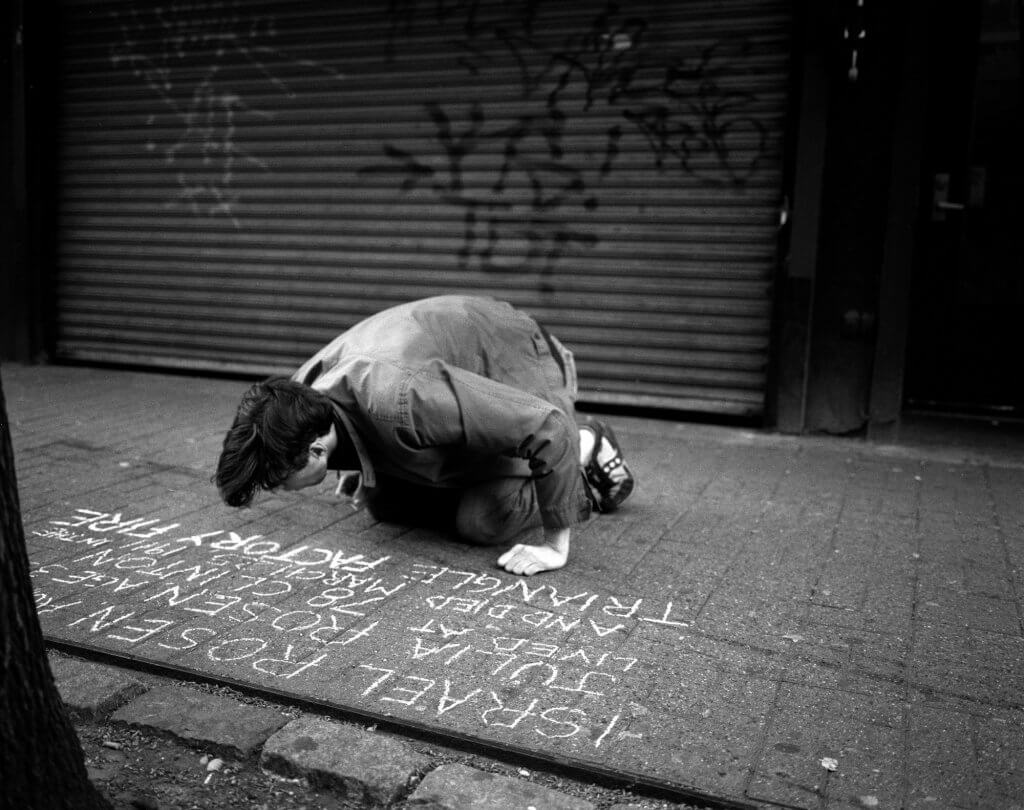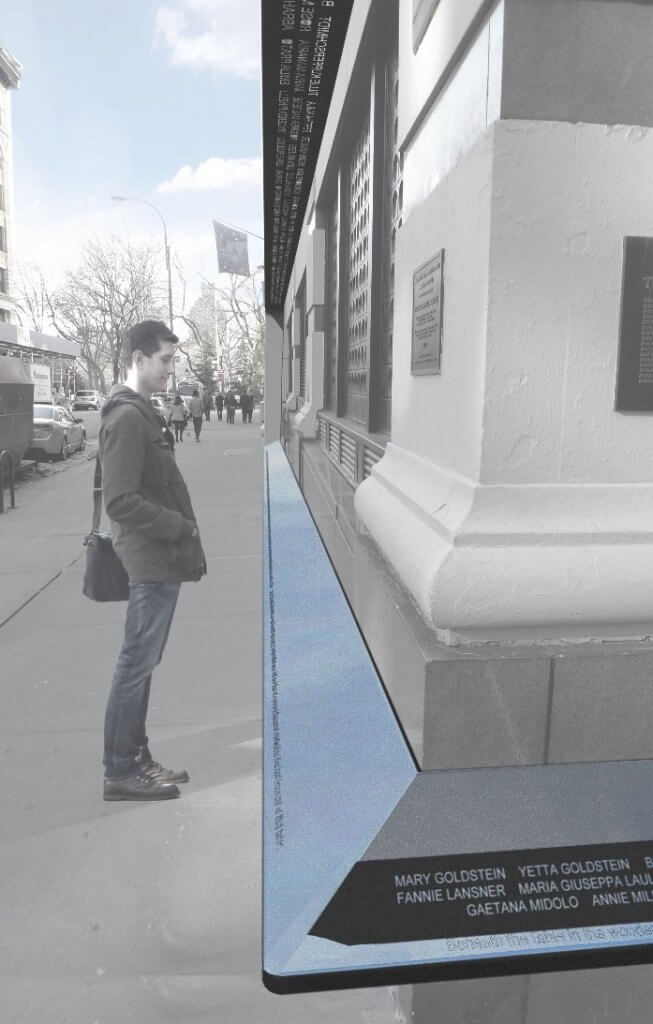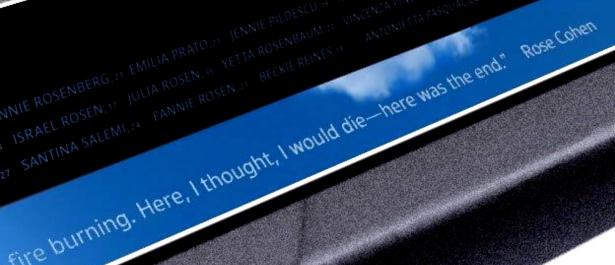Editor: On March 25, 2023 a new memorial will be placed at the site where 123 women and 23 men garment workers, mostly recent immigrants, died in the Triangle Shirtwaist Factory Fire. Mary Anne Trasciatti tells of the long road to bring this memorial to New York City.
In the early 1990s, when I was a graduate student at the University of Maryland, I had an internship at the George Meany Memorial Archives. My task was to organize the AFL pamphlet collection. I don’t think I did a very good job. I was too easily distracted by the content of the collection, and spent more time reading the pamphlets than putting them in any recognizable order. The pamphlets weren’t my only distraction. I was drawn to an exhibit, reproductions of photos and illustrations that told the story of the 1911 Triangle Shirtwaist Factory fire. The terrible images in the photos and pointed commentary of the illustrations first caught my attention. But what drew me back and held me was an excerpt from Morris Rosenfeld’s poem, penned just days after the fire and published in the Jewish Daily Forward:
There will come a time
When your time will end, you golden princes.
Meanwhile,
Let this haunt your consciences:
Let the burning building, our daughters in flame
Be the nightmare that destroys your sleep,
The poison that embitters your lives,
The horror that kills your joy.
And in the midst of celebrations for your children,
May you be struck blind with fear over the
Memory of this red avalanche
Until time erases you.
Every time I read them, the words made me angry and sad at the same time.
I knew about the Triangle fire before my internship. I had learned about it in eighth grade from my social studies teacher, Burt Koza. I also knew about young women in the garment industry. My mother, Ruth Gilboy, had quit high school at the age of seventeen to help support her family by working at Lee Manufacturing, a dress factory in Pittston, Pennsylvania. She told me stories. About how her boyfriend used to request songs for her on the radio station that played in the factory. About how she joined the International Ladies Garment Workers Union. About how, because of the union, she could take a week of vacation with pay or forego the vacation and just take the week’s pay. (She always took the pay.) She also told me about the Triangle fire, what its legacy meant for her and her co-workers, all of them young women as far as I could tell. “We knew we were safe in our factory because of what happened to those poor girls at Triangle.”

Remembering Victim of the Triangle Shirtwaist Fire, New York City, 2010. Photo by Andrew Lichtenstein
In 2009, nearly two decades after my internship, I joined Remember the Triangle Fire Coalition (www.Rememberthetrianglefire.org), a volunteer organization with a mission to connect people to the story of the fire and explore its continuing relevance through the arts, public history programs, and commemorative activities and events. The Coalition was founded with two main goals: to encourage and promote events for the 2011 centennial of the Triangle fire, and to build a permanent memorial that would commemorate the workers who died and pay tribute to the movements for workers’ rights and safety that arose in response to – or were galvanized by – the terrible tragedy. It was a tall order for an organization with no money, no meeting space, and no blueprint to follow, and in Manhattan, of all places, where it seems money and the power that comes with it are everything. My personal connection to the Triangle story and the audacity of the Coalition drew me to the group. Not long after I joined, founder Ruth Sergel asked me to lead the memorial project. As I pondered the idea, I thought about Rosenfeld’s poem, Mr. Koza’s social studies class, and my mother. I also thought about how much work it would take to get a memorial built, although, in retrospect, I really had no clue. I wavered. “I live on Long Island and I don’t know anything about public art.” “You can take the train,” Ruth said, “and you can learn.” I thought it over some more, and said yes.

Rendering of the Triangle Fire Memorial on the Brown Building. Image Credit: Richard Joon Yoo
That “yes” marked the beginning of an odyssey that has lasted over a dozen years. Barring any unforeseen major obstacles, like a natural disaster of historical proportions or a global pandemic, both of which have happened in the course of this project, the Triangle Fire Memorial will be installed on the Brown (formerly Asch) Building where the fire happened and dedicated on the fire’s 112th anniversary, March 25, 2023. It will be New York City’s first labor memorial and one of a small number of public art works in New York that have women as their subject.
Much attention has been paid over the past several years to accounts of monuments and memorials being taken down because the stories they tell and the values they promote are, at best, untenable or, more often, cruel and inhumane. Typically, these accounts center on dramatic acts of destruction or defacement. No surprise there. That’s what makes news. Until the moment of triumph – the dedication – the process of how a monument or memorial comes into being is a lot less newsworthy and a lot more mundane, unless there’s some sort of controversy. The Triangle Memorial Project has certainly had its mundane moments: countless meetings with agencies of city government and elected officials and countless hours poring over the mind-numbing minutiae of contracts, engineering reports, fundraising and financing. The memorial has also had its share of challenges, but there has been no disagreement over whether the fire deserves a memorial and minimal criticism of the memorial’s design. So, why has it taken over a dozen years to complete the memorial? I can identify several reasons.
One reason is the public-private nature of the project. Before the 2011 centennial, the Coalition held a series of open meetings with community groups in Manhattan. At those meetings, people expressed a very strong desire for the memorial to be placed at the site of the fire. In the past, they might have felt differently. Until 1961, commemoration of the fire was not necessarily linked to the Brown Building. It might have involved a citywide fire drill or a trip to the Evergreens Cemetery in Brooklyn where the unknown dead had been buried. For the fiftieth anniversary, Esther Peterson, Director of the U.S. Women’s Bureau for President Kennedy, suggested to ILGWU President David Dubinsky that a significant event be held to mark the occasion. Dubinsky and Leon Stein seized on the idea and planned a ceremony in front of the Brown Building. The ILGWU had a plaque installed on the façade of the building to mark the occasion. In 1991, another plaque was added to indicate that the building had been added to the National Register of Historic Places. In 2003, the building was recognized as a New York City Cultural Landmark and yet another plaque was installed on the façade. By 2011, there was no doubt in anyone’s mind that the memorial had to be installed there as well. However, because the Brown Building is an NYU science building, the Coalition had to secure permission from the university to install a memorial on its property. We were not the first to make such a request, NYU faculty and state politicians had tried before us, but we were the first to succeed. Additionally, because the building is a New York City landmark, the Coalition had to engage the Community Board (CB2) and the Landmarks Preservation Commission (LPC) to inform them about the project. In 2012, the Coalition signed an agreement with NYU that granted us permission to install a memorial on the Brown Building and, in consultation with LPC, indicated what elements of the building could be incorporated into the design. The agreement also stipulated that the Coalition would be responsible for all costs associated with long-term maintenance of the memorial. Soon after signing the agreement, we hired architectural designer Ernesto Martinez to direct an international competition for the design of the Triangle Fire Memorial. A jury of representatives from fashion, public art, design, architecture, and labor history reviewed 170 entries from more than 30 countries and selected a spare yet powerful design by Richard Joon Yoo and Uri Wegman (www.trianglefirememorial.com).

Looking up from the corner of Washington Place and Greene Street
Image Credit: Richard Joon Yoo
The design of the memorial consists of a stainless-steel ribbon that cascades vertically down the corner of the Brown Building (23-29 Washington Place) from the window-sill of the 9th floor, marking the location where most of the victims of the Triangle fire died or jumped to their death. The steel ribbon is etched with patterns and textures from a 300-foot long cloth ribbon, formed from individual pieces of fabric, donated and sewed together by hundreds of volunteers. At the cornice above the first floor, the steel ribbon splits into horizontal bands that run perpendicularly along the east and south facades of the building, floating twelve feet above the sidewalk. The names of all 146 workers who died will be laser-cut through these panels, allowing light to pass through. At street level, an angled panel made of stone glass at hip height will reflect the names overhead. Testimonies from survivors and witnesses will be inscribed in this reflective panel juxtaposing the names and history, memorializing that fatal afternoon.
The next challenge was financial. The initial estimated cost to realize Yoo and Wegman’s design was $1.5 million for capital expenses plus $250 thousand to endow a fund for long-term maintenance. Although $1.75 million is a relatively small amount for a memorial of historical significance in a city like New York, it was an astronomical sum for a ragtag group of volunteers operating on a shoestring budget with zero fundraising experience or expertise. The first thing we did was incorporate as a 501(c) 3 so that we could accept tax-deductible donations. We then held a series of fundraising events. Money came in, but although our network is extensive, it consists primarily of people of modest means and the money we raised was not nearly enough to cover costs. We needed something or someone to help us get attention for the project and attract a major donor. That someone was a stalwart Coalition supporter, also a labor reporter for the New York Times, Steven Greenhouse. In November 2015, Greenhouse wrote an article for the Times with the headline “Coalition Pushes for Memorial to the Triangle Fire.” A few days later, my phone rang. It was a representative from Governor Andrew Cuomo’s administration, saying that the governor would fund the capital costs for the memorial, and would I please send a budget. I sent a budget. A month later, Greenhouse published another article in the Times with the headline “$1.5 million State Grant to Pay for Triangle Fire Memorial.”

Names and ages of Triangle workers killed in the fire will be seen through the reflective panel. Image Credit: Uri Wegman
News that Governor Cuomo had agreed to fund the Triangle Fire Memorial meant the project was now real. We hired an owner’s representative, Gina Pollara, who had led the FDR Memorial Project on Roosevelt Island; an architect of record, Charles Lauster; and a project manager, Peter Homestead. On their recommendation, we signed a contract with KC Fabrications, a union-affiliated company in Gardiner, New York to build the structure. Coalition board members LuLu LoLo, Suzanne Pred Bass, and I, working in concert with Italian activist/scholar Ester Rizzo, revised the list of names and ages of workers killed in the fire to reflect new information from the Italian birth certificates that Rizzo had obtained and U.S. records that had recently become available online. We also hired a graphic designer, Christine Corday, to help us choose a font and to lay out the names and ages as they would be stenciled into the horizontal steel band of the memorial and reflected on the stone glass panel at waist height. Given that most of the workers who died in the Triangle fire were women and girls, we felt very strongly that the font should be designed by a woman. The typeface we chose, Khula, was created by Erin McLaughlin. We also felt that the description of the fire on the memorial should be presented in Yiddish and Italian, the languages of the Triangle workers, as well as English. To my knowledge, the Triangle memorial will be the first tri-lingual memorial in New York, and possibly, in the U.S.
Before fabrication could begin, we had to meet with historical preservationists in Greenwich Village and with CB2 to review the design and discuss the possible impact of the project on the neighborhood. At first, the going was tough. Some residents of a nearby building opposed the project, mostly out of longstanding hostility to NYU and anything or anyone associated with the university. Finally, in 2018, after a public meeting for which the Coalition marshalled twenty supporters to testify in favor of the memorial, including labor organizers, residents of the neighborhood, experts in preservation and urban geography, and family members of garment workers, including Triangle workers, members of CB2 voted 38-1 to endorse the design. In early 2019, we made a presentation to LPC to secure their approval. The vote to approve was unanimous. When I first started to work on this project, few people outside the Coalition believed we could succeed. As we overcame each of these hurdles, our credibility increased. So did donations. Workers United – SEIU and a number of other labor unions made substantial contributions, as did the Sidney Hillman Foundation. More recently, the 21st Century ILGWU Heritage Fund pledged its support. The fashion industry has also contributed. Eileen Fisher and the Council of Fashion Designers of America are among our major donors.

Pedestrian view of the reflective panel.
Image Credit: Max Medley
Then, just as we had gained momentum, the COVID pandemic hit and the project slowed down, as did almost everything else in the world. Slowed down, but did not stop. Our build team continued to meet with NYU’s facilities management team. They conducted a series of tests on the Brown Building to ensure that the building could withstand the weight of the memorial. Those tests revealed serious structural issues that required a new approach to securing the memorial to the building. That new approach required an upward revision of the capital costs from $1.5 million to $2.4 million. Still a relatively small sum for a memorial of this magnitude. Still a lot of money for a group like ours to raise. As I type these words, the Coalition is working to raise the additional funds needed for the memorial from New York City and New York State and from individuals and organizations. I have no doubt we will succeed. We simply will not stop working until we do.
Our belief in the rightness of our undertaking and our shared sense of purpose has created an incredible bond of solidarity among members of Remember the Triangle Fire Coalition. That bond, along with my political convictions and deep feeling of connection to the Triangle story, rooted in my personal history and educational experiences, has sustained me throughout this project. I still feel a mixture of sadness and anger when I read Rosenfeld’s poem. Time has not erased the golden princes. Red avalanches continue to kill workers. But as long as the names of the Triangle dead are seen and spoken they will never be forgotten and they will continue to inspire the struggle for social justice and workplace safety.
Donations to the Triangle Fire Memorial can be made here: http://rememberthetrianglefire.org/donate/
Mary Anne Trasciatti, Professor of Rhetoric and Director of Labor Studies at Hofstra University, is President of Remember the Triangle Fire Coalition. She is co-editor (with Edvige Giunta) of Talking to the Girls: Intimate and Political Essays on the Triangle Shirtwaist Factory Fire (New Village Press, 2022) and (with Robert Forrant) of the forthcoming Where are the Workers? Labor’s Stories at Museums and Historic Sites (University of Illinois Press, June 2022).
View all posts by Mary Anne Transciatti
The Labor and Working-Class History Association is composed of historians, labor educators, and working-class activists who seek to promote public and scholarly awareness of labor and working-class history through research, writing, and organizing.


Spread the word